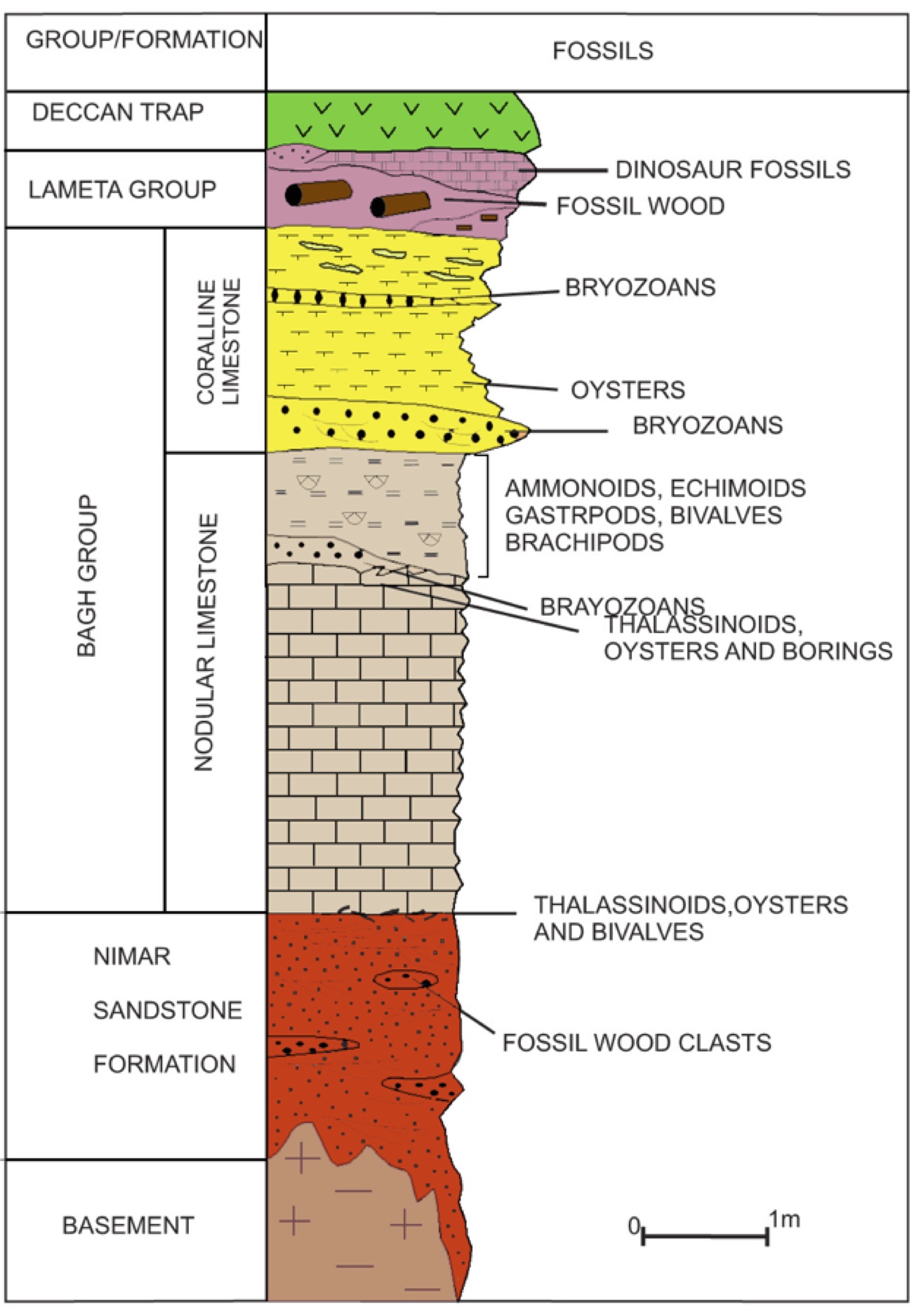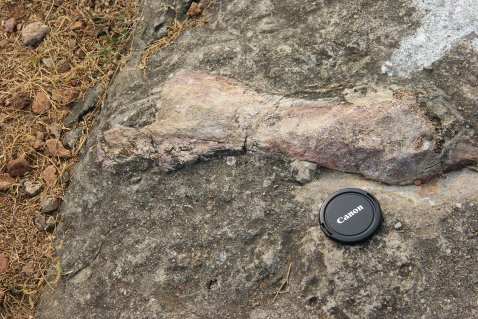Lameta Fm
Type Locality and Naming
Type section is in Lametaghat in Jabalpur. [Original Publication: Medliciott, H.B. (1872). Note on the Lameta or infrastrappean formation of Central India. Records of the Geological Survey of India, 5(4): 115-120.]. Reference well: Chui Hill, Bara Simla Hill, Chota Simla Hill, Jabalpur
[Figure 1: (A) Map showing some of the important outcrops (shaded) of Lameta Beds in the Narmada Basin in central and western India. (B) Sketch map showing the location of the Chui Hill (Jabalpur), Lametaghat and Sivni Tola sections (Narmada river) (adapted from Tandon et al., 1995; Tandon & Andrews, 2001)]
[Figure 2: Lametaghat Type Section of the Lameta Formation, Jabalpur]
[Figure 3: Reference sections of the Lameta Formation in Jabalpur town]
Lithology and Thickness
Sandstone and Limestone. Originally the Lameta Formation was divided into five mappable units, namely Green Sandstone, Lower Limestone, Mottled Nodular Bed, Upper Limestone and Sandy Zone. Tandon et al. (1995) followed four-fold classification by retaining the three older units and merging Upper Limestone and Sandy Zone into Upper Calcified Sandstone.
[Figure 3b: Composite stratigraphic column of the Bagh Group (after Tripathi, 2006)]
[Figure 4: Schematic stratigraphic log of the Lameta Formation in Jabalpur (adapted from Tandon e t al., 1995; Tandon & Andrews, 2001)]
[Figure 5: Outcrop of the Lameta Formation on the left side Bagh –Jobat road, near Bagh town, Dhar district, Madhya Pradesh]
[Figure 6: Outcrop of the Lameta Formation in Chui Hill section, Jabalpur town]
[Figure 7: Litholog, lithofacies divisions and interpretations of the Lower Limestone at Chui Hill (Jabalpur). Black and white scale bars are 1 m (adapted from Tandon & Andrews, 2001)]
Relationships and Distribution
Lower contact
In Jabalpur area: Overlies the Jabalpur Fm with a paraconformity.
In Bagh-Kukshi area: Unconformably overlies the Coralline Limestone Fm or Nodular Limestone Fm.
In Balasinor area: Unconformably overlies Precambrian metasediments and granites.
In Bairam, Belkher, and Salbardi aeas of Amravati district of Maharashtra and Betul district of Madhya Pradesh: Overlie the Gondwana Group of sediments with a disconformity.
Upper contact
In Jabalpur area: Unconformably overlain by Deccan Traps Fm.
In Bagh-Kukshi area: Unconformably overlain by the Deccan Traps Fm basaltic flows.
In Balasinor area: Unconformably overlain by Deccan Traps Fm basalts.
In Bairam, Belkher, and Salbardi aeas of Amravati district of Maharashtra and Betul district of Madhya Pradesh: Underlie the Deccan Traps Fm with a sharp contact.
Regional extent
The Lameta outcrops outside Jabalpur have been documented from Zeerabad-Bagh-Kukshi areas of Dhar district and Betul district of Madhya Pradesh, Balasinor area of Dohad district in Gujarat and Nand-Dongargaon Basin in Chandrapur district, Maharashtra. In western part, the outcrops of the Lameta Formation are known occur over a length of 40 km and a width of 15 km in Kheda and Panchmahal districts of Gujarat (Kumar et al., 1998)
GeoJSON
Fossils
The Lameta Formation is long known for its dinosaur skeletal remains and nesting sites. These dinosaur remains have been documented from the Bara Simla Hill, Chota Simla Hill, Chui Hill, and the Lameta Ghat sections.
Fish: Lepisosteus indicus, Pycnodus lametae, Eoserranus hislopi (Woodword, 1908); Sauropod dinosaurs: Jainosaurus septentrionalis, Isisaurus colberti, Titanosauriformes indet.; Theropod dinosaurs: Rajasaurus narmadensis, Rahiolisaurus gujaratensis, Indosuchus raptorius, Indosaurus matleyi, Laevisuchus indicus, Lametasaurus indicus are reported from the "carnosaur" bed lying over the limestone; Dinosaur Oospecies: Megaloolithus cylindricus (Khosla and Sahni 1995), M. jabalpurensis (Khosla and Sahni 1995), M. megadermus (Mohabey 1998), M. dhoridungriensis (Mohabey 1998), M.khempurensis (Mohabey 1998), Fusioolithus baghensis (Khosla and Sahni 1995; Fernandez and Khosla 2015), F. padiyalensis (Khosla and Sahni 1995; Fernandez and Khosla 2015), F. mohabeyi (Khosla and Sahni 1995; Fernandez and Khosla 2015), and F. dholiyaensis (Khosla and Sahni 1995; Fernandez and Khosla 2015); Snakes: Sanajeh indicus (Wilson et al,., 2010); Turtles: Carteremys pisdurensis (Jain, 1977; 1986), Jainemys pisdurensis (Joyce & Bandyopadhyay, 2020). These beds have also yielded charopohytes: Platychara cf. sahnii, Nemgtichara grambastii, Microchara sp., freshwater aquatic pulmonates including Paludina, Physa and Lymnaea, Ostracods including Cyprinotus, Para- cypretta, Eucandona and Darwinula, and Charophytes including Microchara, Peckichara and Platychara (Sahni and Jolly, 1990). Vertebrate microfossils including scales of Phareodus an osteoglossid fish, Lepisosteus, pycnodontids, Igdabatis (Sahni, 1984; Brookfield and Sahni, 1987; Sahni et al., 1994). Igdabatis--a myliobatid is also reported (Besse et al., 1986; Courtillot et al., 1986) from the Upper Sandstone unit at Burgi. Dogra et al. (1988, 1991) documented a Maastrichtian palynofossil assemblage that includes Ariadnaesporites punctatus, Leptolepidites verrucatus, Proxapertites crassimurus, Palmidites maxirnus, Liliacidites microreticulatus, Aquilapollenites indicus, A. bengalensis, Aquilapollenities andamanensis, Scollardra conferta and Dinogymnum sp. from the type area of the Lameta Formation. Biostratigraphically, the Lameta Formation has been divided into the lower Aquliapollenites indicus Zone and upper Prozxapertites cressimurus Zone.
[Figure 8: Dinosaur bone in the Lameta outcrop at Dinosaur National Fossil Park at Rahioli, Balasinor, Gujarat]
Age
Depositional setting
Interpretations on depositional environment of the Lameta Formation varied from terrestrial (Medlicott, 1872; Matley, 1921), to shallow marine (Chanda, 1963a, b), to fluvial and marine (Kumar & Tandon, 1977, 1978) and to tidal and estuarine environments (Singh & Srivastava, 1981; Singh, 1981). Tandon et al. (1995) and Tandon and Andrews (2001) based on detailed sedimentological and stable isotope analyses of Lameta sediments from the Jabalpur area made the following interpretations on its paleoenvironments. According to them, Green Sandstone was interpreted as accumulations in southwest oriented fluvial channels. The Lower Limestone facies and their lateral variations indicated subaerially exposed low-gradient alkaline flat in an alluvial setting. The mottled Nodular Beds were interpreted as pedogenically modified sheetwash deposits of a semi-arid alluvial plain. The Upper Calcified Sandstone was interpreted to have been deposited by unchanneled sheet-floods.
Additional Information
The Lameta Formation is long known for its dinosaur skeletal remains and nesting sites (Huene & Matley, 1933; Sahni et al., 1994).
 of Lameta Beds in the Narmada Basin in central and western India..jpg)
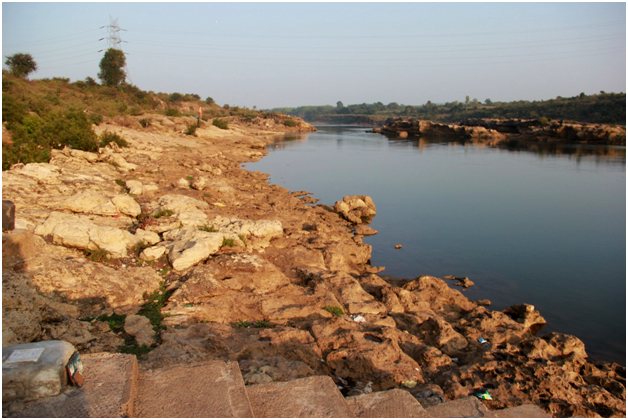
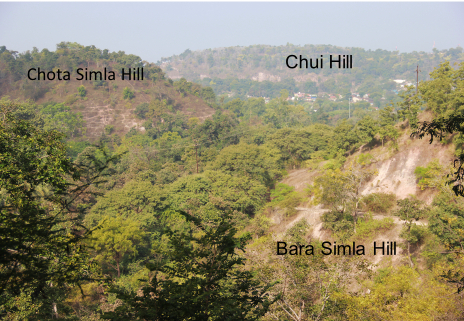
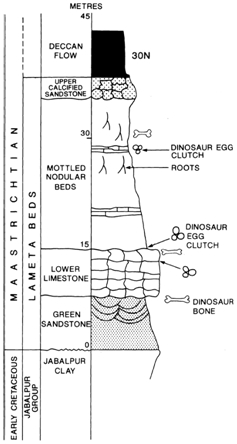

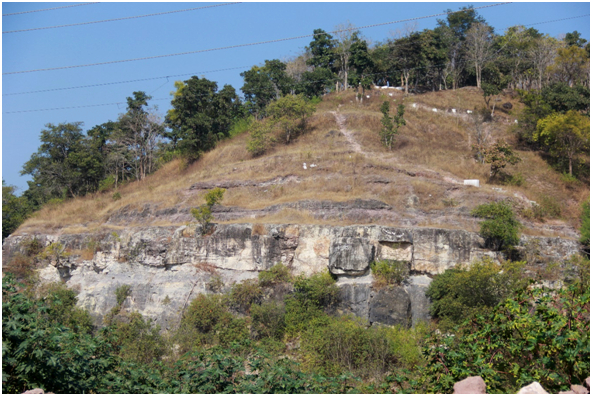
..jpg)
